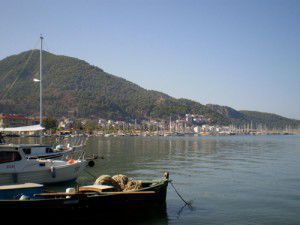Pure and simple?
Recently, Alex wrote about the way languages borrow words from each other. She pointed out that in English, we’re always using words from other languages, sometimes without even realising it, with déjà vu, karate and Zeitgeist being just a few examples.
But is this mixing of languages a good thing, or should languages remain ‘pure’?
Hoji Takahashi, a 71-year-old man from Japan, hit the headlines a few weeks ago when he sued the country’s public TV station, NHK, for the mental distress he’s suffered as a result of them using too many words derived from English. A couple of the examples given were toraburu (trouble) and shisutemu (system).
He’s not alone – many elderly Japanese people have trouble understanding these ‘loan words’, and the government has apparently been under pressure for over ten years to try and do something about the dominance of American English in Japan, which has been growing ever since World War II.
The lawsuit is quite controversial, with some dismissing it as ridiculous and others giving Mr Takahashi their full support. But whatever your view, it does raise an interesting question – one that we at EuroTalk often face when translating the vocabulary for our software. Should we go with the word that people most often use, or the one that’s technically correct in the original language?
It’s a difficult decision, particularly when translating for people who want to learn a language, because we know that we have a responsibility to get it right; language learners are putting their faith in us to teach them the correct words, so they’ll be able to speak to people and won’t be embarrassed by saying the wrong thing. But at the same time, the ‘correct’ word might not be the one that they’ll actually need when they get to wherever they’re going. This is particularly the case with African languages, where many words are adapted from French, and indigenous South American languages, where the Spanish influence is very clear. And it can be frustrating for someone who’s just starting to learn a new language to find that half the words are not actually in that language at all.
A few examples:
– In Maltese, the correct word for ‘airport’ is ‘mitjar’, but everyone says ‘arjuport’.
– In Swahili, although ‘tomato’ is ‘nyanya’, ‘tomato ketchup’ is known as ‘tomato’, although the technically correct translation is ‘kechapu ya nyanya’.
– In Tumbuka, when counting to 20, Tumbuka numbers are used, but beyond 20 the numbers revert to English.
There are many more examples, as we’ve discovered over the years and particularly when working on the translations for the new uTalk app. Each new translation is carefully considered and discussed to decide on the best choice from a practical point of view, selecting the word most people would actually use in real life – even if this means some people, like Mr Takahashi, don’t agree with the final result.
What do you think? Should language learning software teach a language in its purest form, or is it better to learn the words that are most commonly used, even if they’re borrowed from another language?
Liz
Could you repeat that, please?
Today’s guest post is from Sian, a British ex-pat living in Turkey, who has some advice for anyone considering moving abroad.
Merhaba. Last year I made a life changing decision and decided that, at the age of 42, I wanted to leave the UK and move to Turkey. After much research, a lot of visits to the vets to ensure my two elderly cats could come, and a lot of packing and sorting out, the day finally came and on April 15th this year I moved lock, stock and barrel to Fethiye (you can follow my story on my blog, To Fethiye and Beyond).
Have I regretted it? Absolutely not. Would I advise other people to give it a try? Oh yes. Is it hot? Like you wouldn’t believe. Would I suggest that they learn some of the language before they came? Definitely. Unfortunately I didn’t follow my own advice and barely learnt more than 3 or 4 words before coming out here. Luckily for me, I armed myself with a EuroTalk Turkish DVD before I left so, yes, I do know a lot more Turkish now than when I arrived – although I still sometimes struggle with the simplest of words, the main one being teşekkürler, which means thanks – for some reason I keep thinking of it as ‘testicular’ which is not going to win me any friends (well, not the right sort anyway!).
Not only is the Turkish language very hard, what with its ‘i’ with a dot that is pronounced like ‘ee’, its ‘l’ without a dot (that isn’t an L) that is pronounced like a ‘u’, its ‘c’ that is pronounced like a ‘j’, while the ‘j’ is pronounced like an ‘s’ (seriously, who thought up this language!)… but the local people here also love to practise their English. You may start with every intention of saying something in the local language but as soon as they spot you they say hello, how are you and your brain just goes to mush and you respond in English.
Mind you, something must be sinking in as I did actually manage to have a conversation in Turkish just the other day. Admittedly it wasn’t the longest of conversations but we’ve all got to start somewhere, haven’t we?

I absolutely refuse to be a parody of a Brit abroad and spend the rest of my life speaking v-e-r-y s-l-o-w-l-y in English to the locals in a slightly patronising manner so I am going to keep on going with the EuroTalk DVD and hopefully by the end of the year I’ll be able to manage an even longer conversation!
And on that note I’ll say görüşürüz and wish you all a pleasant day.
Are you moving abroad? Let us know! We’d love to help you start learning the basics of your new country’s language.
What’s in a name?
Today’s post is written by Simona, who’s from the Czech Republic and working with us here at EuroTalk on the translation and recording of the maths apps. Read on to discover how the Czech language names the months of the year, and to find out how you can win a free EuroTalk download or uTalk app…
Most learners of foreign languages encounter months of the year soon after they start studying. If you have ever tried to learn months of the year in German, French, Italian, Spanish or Russian, you probably found it simple because they are quite similar to the English ones. The reason is those words were derived from Latin. This is not the case with Czech and Polish (with the exceptions of marzec [March] and maj [May] in Polish). But as a native speaker of Czech, I will focus in this post on the Czech names for months. Our terms are derived from words connected with weather, cycles in nature and land cultivation. Let us have a look at what the Czechs call months of the year and what the words mean:
 January = leden: led means ice in Czech; weather in the Czech Republic in January is severe with average temperatures below zero.
January = leden: led means ice in Czech; weather in the Czech Republic in January is severe with average temperatures below zero.
February = únor: in Old Czech a verb unořit se means that frozen land starts to thaw, which usually happens in February.
March = březen: this word was probably derived from an adjective březí which means gravid (used solely with animals) or from bříza, a birch which begins to sprout in the Czech Republic in March.
April = duben: dub is a Czech word for an oak which begins to sprout in April.
June = červen + July = červenec: červený means red: during those two months all the summer fruits, such as cherries, sour cherries, peaches, strawberries and raspberries turn red.
August = srpen: srp is a sickle used mostly in September to harvest crops.
September = září: zářit means to shine and the verb is often used in the context of sunshine.
October = říjen: říje is a word for the rutting season of deer.
November = listopad: listopad is a compound word which consists of list – a leaf – and pád – a fall. November is the month when trees lose their leaves.
December = prosinec: the word is derived from proso, which means millet. Historically, December was a harsh month for people in my country. They had to rely on their food supplies, which were limited, and therefore usually ate simple meals. One of the commonest was millet mash.
It is noteworthy that although the Czechs and Slovaks were one nation for so long and the Czech and Slovak languages are like two peas in a pod, the Slovaks call months Január, Február, Marec, Apríl and so on, following the Latin model.
Working for EuroTalk has brought me a lot of experience – not just the professional one for my budding translation career, but it also helps me to get some distance from my mother tongue and realise that what we sometimes consider natural and pretty obvious in our language, others from different cultural backgrounds may find interesting. A stay abroad and communication in a foreign language make you look at things with new eyes.
Simona
Do you want to win a free EuroTalk download or uTalk app? Here’s your chance…
In your language, are the months named according to the Latin model? If so, can you come up with some more exciting names for them? We’re offering a free EuroTalk download or uTalk app for the most original suggestion (chosen by us!). Post your ideas in the comments below – with explanations – before 19th August to be in with a chance to win 🙂
How the scripts hit the streets
I quite like the way that the iconography of foreign languages and exotic scripts happily manages to pervade our popular culture. It’s all over the place – it’s on the streets, we wear it , we eat it, we watch it and much of the time we have a laugh. And we have a bunch of rather clever advertisers and retail brands to thank for it.
Shall we begin with a little Latin? If you’ve been watching O2’s hilarious ‘be more dog‘ ads or sat at one of the 10,000,000 bus stops in London you will now know that the timeless rallying cry Carpe Diem has hit the streets. And, once you’ve had a hoot at the cat-that-turns-into-a-dog footage, you’ll have learnt that Carpe Diem means… ‘Grab the Frisbee’. I somehow think that Horace, who wrote the words c. 50 BC, would have agreed it was not too bad a translation for 2013 AD. I love the idea that some Latin is out there and available to all, a call to make the most of it, to seize the day!
So make a noise for VCCP, the agency who dreamt the whole campaign up; as an ex JWT exec myself , I am impressed.
And now to Japanese. How many of you think that the Superdry clothing brand, with its cool hoodies, tops and t-shirts plastered with Kanji and Hiragana, comes from Japan? Sorry to disappoint, but Superdry has its origins not in an office in downtown Tokyo, but in a market stall in Cheltenham, where a guy called Julian Dunkerton began selling branded clothing and later had the idea to use Japanese script on his clothing. And the rest, as they say, is history – Julian is now the Chief Exec of one of the UK’s top clothing companies.
It may be reassuring to know that although the company itself is no more Japanese than a benko box from Pret, I am told that the writing is not gobbledygook but does actually mean something: which I am sure is neither unprintable, nor deeply philosophical, but I rather like the idea of millions of people in London walking around with Japanese on their backs – and their fronts.
Of course I am not attempting to connect any of this to a serious attempt to learn a language – though the thought of people queuing up to take degrees in Classics and Japanese is a most appealing one.
However, I’m sure that most of us have at least some interest in the world around us, and iconic branding and imagery can often excite our curiosity, make us think a bit and have us see the world in a slightly new and refreshing way.
Steve
(Photo courtesy of Superdry.com)
If at first you don’t succeed…
Gloria’s post today is about her work on the EuroTalk roof garden, which is a lovely place for us to enjoy in the summer sunshine. Getting it that way hasn’t been easy, but the end result shows that sometimes it’s worth persevering. The same could be said for learning a language!
When I was first handed responsibility for looking after the roof garden at EuroTalk I felt quite smug. Easy – or so I thought! And a good reason (or excuse?) for removing myself from the computer screen quite often. I have a large garden at home, so I already have a lot of experience in planting, pruning, weeding and watering etc. What’s more – I know it’s an ongoing task for at least nine months of the year, so I expected a lot of hard, back-breaking work in the open air. I wasn’t wrong!
What I didn’t bargain for was the changing face of EuroTalk.
 Last summer (2012) I had a beautiful display of colours blending up on the roof. My favourites are the pinks and mauves, so I’d planted a whole lot of flowers in these colours. By June the roof garden was looking really healthy and beautiful and I felt that all my backaches had been worth it. Then it happened!
Last summer (2012) I had a beautiful display of colours blending up on the roof. My favourites are the pinks and mauves, so I’d planted a whole lot of flowers in these colours. By June the roof garden was looking really healthy and beautiful and I felt that all my backaches had been worth it. Then it happened!
In July the builders moved in. They erected scaffolding on the terrace and moved a lot of the pots to safer places while they worked on building a new room and putting in a panoramic window which formed the entire exterior wall of this extension. But this took time – nine months, to be exact. I could have had a baby in that length of time (well I couldn’t, but one of our younger staff did!)
The two canvas sails, which had created shade for anyone sitting at the huge wooden table, were removed and allowed to hang up against a wall, thus preventing both light and rain water from reaching a number of the troughs and pots throughout the autumn and winter. Builders rubble appeared out of nowhere – bricks, cement, wood, plastic bags and sacks etc. – you name it and it appeared on our lovely roof terrace. I sat and cried, and vowed to myself that someone else could sort it all out once the building work was finished. I’d had enough. I felt totally disillusioned at all my hard work being destroyed.
Although I went on to the roof garden several times during those dark months, I wasn’t able to do much other than put some water on the dried out pots and cross my fingers!
Then finally, in March 2013 the building work was completed. On the third attempt, the panoramic window was finally fitted satisfactorily and the scaffolding eventually disappeared. The rubble was cleared away and all the pots were put back into place. The builders did a very good job of cleaning the roof garden and the artificial turf began to look like real grass once more. Even the cigarette ends disappeared.
Then began the task of resurrection. A number of visits to the garden centre worked wonders. Then the automatic watering system caused a number of problems. Not all pots had feeds off the main, so this had to be sorted out. Once we had additional bits and pieces, again I thought it was finished. Not so. The older bits didn’t like working with the newer ones so another visit to the garden centre was required. With help from two of my colleagues (Alan and Steve) it is now working correctly. Fingers crossed again!
 I split and transferred the crocosmia so that both cauldrons now contain orange crocosmia and a potentilla – one yellow and one white. The main pots and troughs are back up and in full flower, mainly pinks and mauves of course, but with a few other colours added for variety. I’d managed to salvage the lavenders, but it took a lot of T.L.C. and I’m now happy once more with the result – a verdant, lush, colourful display.
I split and transferred the crocosmia so that both cauldrons now contain orange crocosmia and a potentilla – one yellow and one white. The main pots and troughs are back up and in full flower, mainly pinks and mauves of course, but with a few other colours added for variety. I’d managed to salvage the lavenders, but it took a lot of T.L.C. and I’m now happy once more with the result – a verdant, lush, colourful display.
With the constantly changing colours and differing amounts of foliage as the year progresses, I see it as a kaleidoscope of never-ending challenges. And I’m currently rooting some chocolate mint on my desk to replace the one that shrivelled from lack of water. Yipppeeee – it’s working.
But I’m begging our bosses, please don’t plan to do any more extensions. My back and my temper can’t take it…….
Gloria




